This article lists the postures of the Primary Series as taught by BNS Iyengar, along with a rendering of the encompassing vinyāsa.1 The postures are identified first in Sanskrit and then in English translation, with audio clips for pronunciation and miscellaneous notes. For best results, please review the article on basic terms.
It is important to bear in mind that, just as the postures themselves should be modified to individual bodies and needs, so the encompassing vinyāsa count should treated as aspirational only and should be subject to adjustment. Even experienced persons who come to the practice with considerable bodily gifts find themselves adding breaths, especially as they move into or out of postures.
sūryanamaskāra Sequences
Pronunciation
Analysis: sūrya + namaḥ + kāra
English: Making a Bow to the Sun (AKA: Sun Salutations)
Andrew Eppler says that sūryanamaskāra are the meter and scale of the “song” that is the Primary Series.
sūryanamaskāra A Sequence


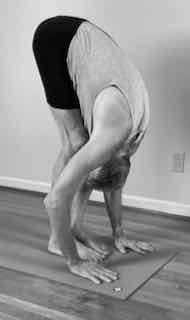
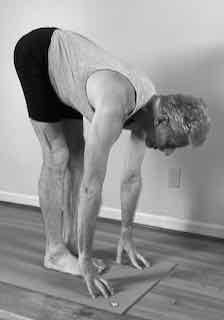
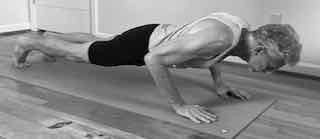
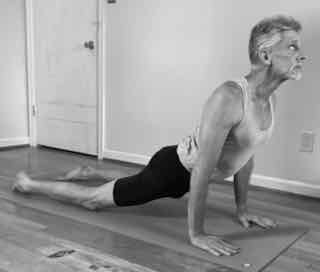
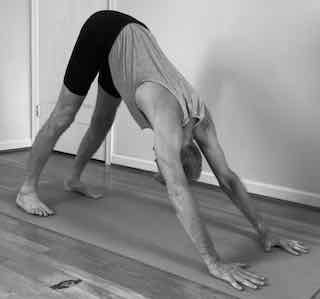




Repeat this sequence 4-5 times. Only one posture of the sequence (adhomukhaśvānāsana) is held.
Begin in samasthitiḥ (“Even Standing”).
- inhale: raise arms and look up, to ūrdhvavṛkṣāsana (Upward Tree Posture)
- exhale: fold down to uttanāsana A (Stretching Out Posture A)
- inhale: straighten the spine and look forward but stay down (this is uttanāsana B, Stretching Out Posture A)
- exhale: jump/step back to caturaṅgadaṇḍāsana (Four-Limbed Stick Posture)
- inhale: press up, bending back and looking up, to ūrdhvamukhaśvānāsana (Upward-Face Dog Posture)
- exhale: to adhomukhaśvānāsana (Downward-Face Dog Posture). This posture is held for five complete breaths.
- inhale: jump/step forward to uttanāsana B
- exhale: fold down to uttanāsana A
- inhale: up to ūrdhvavṛkṣāsana
- exhale: to samasthitiḥ
sūryanamaskāra B Sequence

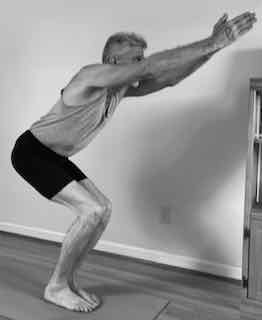







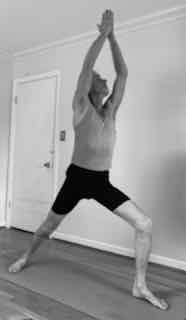





Repeat this sequence 3-4 times as needed. Again only one posture of the sequence (adhomukhaśvānāsana)(is held, and then only in its third occurence.
Begin in samasthitiḥ from the final iteration of the sūryanamakāra A sequence.
- inhale: raise arms and look up, to ūrdhvavṛkṣāsana (Upward Tree Posture)
- exhale: fold down to uttanāsana A (Stretching Out Posture A)
- inhale: straighten the spine and look forward but stay down (this is uttanāsana B, Stretching Out Posture A)
- exhale: jump/step back to caturaṅgadaṇḍāsana (Four-Limbed Stick Posture, ommonly known as Plank)
- inhale: press up, bending back and looking up, to ūrdhvamukhaśvānāsana (Upward-Face Dog Posture)
- exhale: to adhomukhaśvānāsana (Downward-Face Dog Posture). Do not hold this posture.
- inhale: step right foot forward between hands, come up to vīrabhadrāsana A (Auspicious Hero Posture A)
- exhale: step the right foot back, come down into caturaṅgadaṇḍāsana
- inhale: press up into ūrdhvamukhaśvānāsana
- exhale: to adhomukhaśvānāsana. Again, do not hold this posture.
- inhale: step left foot forward between hands, come up to vīrabhadrāsana A (Auspicious Hero Posture A)
- exhale: step the left foot back, come down into caturaṅgadaṇḍāsana
- inhale: press up into ūrdhvamukhaśvānāsana
- exhale: to adhomukhaśvānāsana. This time, hold the posture for five complete breaths.
- inhale: jump/step forward to uttanāsana B
- exhale: fold down to uttanāsana A
- inhale: up to ūrdhvavṛkṣāsana
- exhale: to samasthitiḥ
Standing Sequence
pādāṅguṣṭhāsana
Pronunciation
English: Thumb to Foot Posture
Note: Possibly “Big Toe of the Foot Posture”, as aṅguśṭha means both “thumb” and “big toe”.
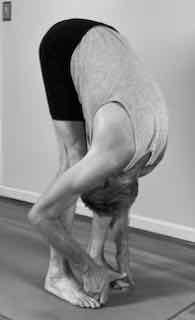
Entering vinyāsa (4):
- inhale: step left, hands to hips, look up
- exhale: fold forward
- inhale: straighten, look up
- exhale: fold
(Here Andrew stays down for the next posture. Joey Paz exits with four vinyāsa, ending in samasthitiḥ.)
pādahastāsana
Pronunciation
English: Hand under Foot Posture
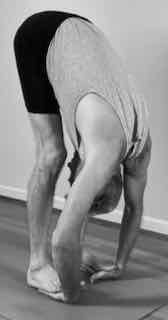
Entering vinyāsa (4):
- inhale: look up, hands to hips
- exhale: hands under feet
- inhale: look up
- exhale: fold
Exiting vinyāsa (4, ends in samasthitiḥ):
- inhale: look up, hands to hips
- exahle: fold
- inhale: up
- exhale: step back to samasthitiḥ
trikoṇāsana
Pronunciation
English: Triangle Posture
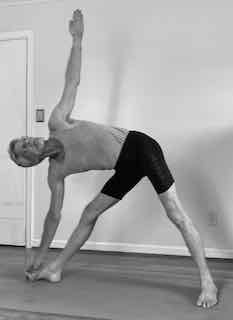
Entering vinyāsa (2):
- inhale: step to the left, feet a bit more than a leg’s length distance apart, spread arms, “fix” the feet
- exhale: fold down to the right
Transition vinyāsa (2):
- inhale: rise up, fix feet the other way
- exhale: fold down to the left
Exiting vinyāsa (1):
- inhale: rise up, fix feet the other way
parivṛttatrikoṇāsana
Pronunciation
English: Revolved Triangle Posture
Note: parivṛtta = “turned around”, “revolved”.
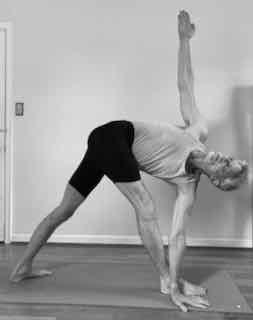
Entering vinyāsa (1):
- exhale: fold and twist down and to the right
Transition vinyāsa (2):
- inhale: rise up, fix feet the other way
- exhale: fold and twist down and to the left
Exiting vinyāsa (2):
- inhale: rise up, feet back to neutral
- exhale: step back to samasthitiḥ
parśvakoṇāsna
Pronunciation
English: Side Angle Posture
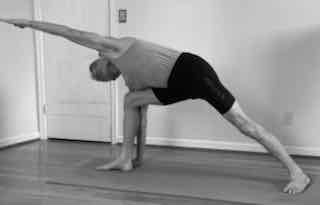
Entering vinyāsa (2):
- inhale: step to the left, feet quite a bit more than a leg’s length distance apart, spread arms, “fix” the feet
- exhale: bend right knee over ankle, fold down to the right
Transition vinyāsa (2):
- inhale: rise up, fix feet the other way
- exhale: bend left knee over ankle, fold down to the left
Exiting vinyāsa (1):
- inhale: rise up, fix feet the other way
parivrttaparśvakoṇāsana
Pronunciation
English: Revolved Side Angle Posture
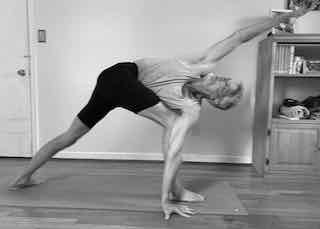
Entering vinyāsa (1):
- exhale: bend right knee over ankle, fold and twist down and to the right
Transition vinyāsa (2):
- inhale: rise up, fix feet the other way
- exhale: bend left knee over angle, fold and twist down and to the left
Exiting vinyāsa (2):
- inhale: rise up, feet back to neutral
- exhale: step back to samasthitiḥ
prasāritapādottānāsana
Pronunciation
Analysis: prasārita + pāda + uttāna + āsana
English: Stretching Out to Spread Feet Posture
Note: prasārita is literally “caused to flow forth”, and can mean “spread”. The feet are spread apart from each other.
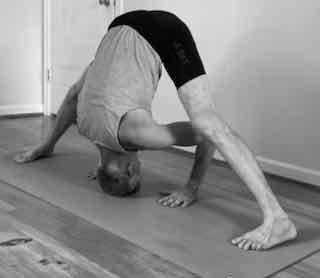
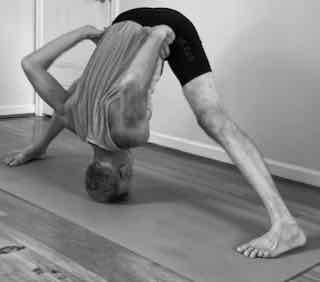
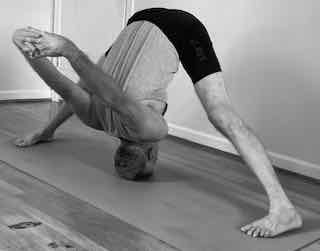
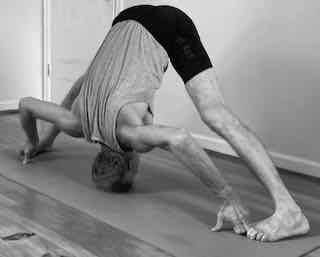
There are four phases: A, B, C, D.
Entering vinyāsa for A (4):
- inhale: step to the left, feet quite a bit more than a leg’s length distance apart, spread arms
- exhale: hands on hips
- inhale: arch back, look up
- exhale: fold forwards, hands (and maybe head) on floor
Exiting vinyāsa from A (4):
- inhale: straighten the spine, look up but stay down
- exhale: hands on hips
- inhale: stand, arms out
- exhale: hands to hips
Entering vinyāsa for B (4):
- inhale stand, arms spread
- exhale hands to hips, elbows trending toward each other behind you
- inhale look up
- exhale fold down, head maybe on floor
Exiting vinyāsa from B (2):
- inhale: stand
- exhale: hands to hips
Entering vinyāsa for C (4):
- inhale: spread arms
- exhale: clasp ahnds behind back
- inhale: arch back, look up
- exhale: fold down, head maybe on floor, hands on floor a distant possibility
Exiting vinyāsa from C (2):
- inhale: stand
- exhale: release clasp, hands to hips
Entering vinyāsa for D (4):
- inhale: up arms wide
- exhale: hands to hips
- inhale: arch bak, look up
- exhale: fold down, grab big toes, head maybe on floor
Exiting vinyāsa from D (4):
- inhale: straighten the spine, look up but stay down
- exhale: hands on hips
- inhale: stand, arms out
- exhale: step forward to samasthitiḥ
parśvottānāsana
Pronunciation
English: Stretching Out to the Side Posture
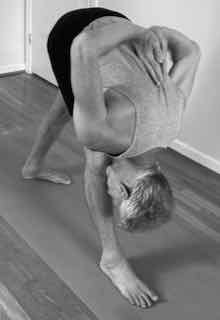
Entering vinyāsa (4):
- inhale: step left arms wide, less than a leg’s width distance between feet
- exhale: hands to reverse namaste
- inhale: fix feet, turn torso to right, arch back and look up
- exhale: fold into posture
Transition vinyāsa (4):
- inhale: rise back up, arch back and look up
- exhale: rotate to left, fixing feet other way
- inhale: arch back, look up
- exhale: fold
Exiting Vinyāsa (2):
- inhale: rise back up, look up
- exhale: release hands, open arms, step forward to samasthitiḥ
Primary Series Postures
utthitahastapādāṅguṣṭhāsana
Pronunciation
English: Standing Hand-to-Big-Toe-of-the-Foot Posture
Note: utthita = “stood up”, thus “standing”.



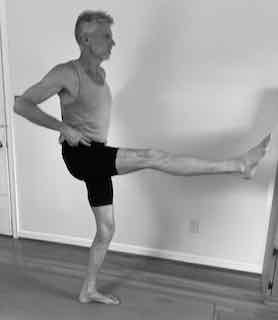
There are four phases: A, B, C, D.
Entering vinyāsa for A (2):
- inhale: raise the right leg, taking the big toe with thumb and first two fingers
- exhale: extend the leg as much as possible.
Transition to B:
- inhale: open leg to the right
- exhale: turn head to the left
Transition to C:
- exhale: return the leg to center
- inhale: shift right hand to grip foot under the sole; release left hand from hip, bring it toward the right foot
- exhale: add left hand to the undersole grip on the right foot
Transition to D:
- inhale: release hands from foot
- exhale: place hands on hips
Exiting from D:
- exhale: lower the leg, returning to samasthitiḥ
Then perform all four phases using the left leg.
ardhabaddhapadmottānāsana
Pronunciation
English: Stretching out in Half Bound Lotus Posture
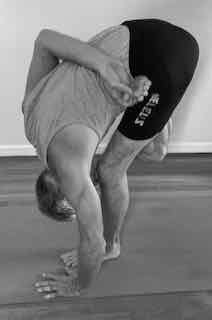
Entering vinyāsa (4):
- inhale: right leg into half-lotus
- exhale: right hand reaches behind back to grab right foot
- inhale: lift left hand
- exhale: fold forward, left hand on floor outside of left foot, head maybe to left leg
Exiting vinyāsa (4):
- inhale: straighten spine and look forward but stay down
- exhale: hold
- inhale: stand up
- exhale: release foot, return to samasthitiḥ
Repeat posture on the left side.
utkaṭāsana
Pronunciation
English: Fierce Posture
Note: utkaṭa = “exceeding the usual measure, immense, gigantic”.
Note: Some people say that in this posture the body resembles a jagged lightening-bolt. This may come from a lesser-used meaning of utkaṭa: “uneven”.
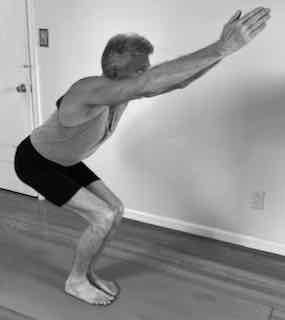
Entering vinyāsa (2):
- inhale: lift arms, squat
- exhale: mostly hold, but settling slightly into the squat
Exiting vinyāsa (2):
- inhale: stand up straight
- exhale: lower arms, returning to samasthitiḥ
vīrabhadrāsana
Pronunciation
English: Auspicious Hero Posture
Note: vīra = hero, warrior. bhadra = blessed, auspicious". Vīrabhadra" is the name of an incarnation of Śiva. Monier-Williams says:
… in the Vāyu-Purāṇa he is said to have been created from Śiva’s mouth in order to spoil the sacrifice of Dakṣa, and is described as having a thousand heads, a thousand eyes, a thousand feet, and wielding a thousand clubs; his appearance is fierce and terrific, he is clothed in a tiger’s skin dripping with blood, and he bears a blazing bow and battle-axe; in another Purāṇa he is described as produced from a drop of Śiva’s sweat.

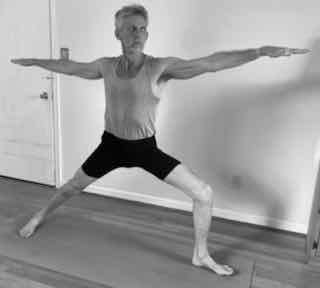
There are two phases: A and B.
Entering vinyāsa into A (4):
- inhale: step left, arms wide
- exhale: turn right, bend right knee over ankle
- inhale: lift arms, look up
- exhale: hold
]Transition vinyāsa to other side (5):
- exhale: lower arms
- inhale: turn left 90 degrees
- exhale: turn left remaining 90 degrees, bend left knee over ankle
- inhale: lift arms, look up
- exhale: hold
Transition vinyāsa to B (3):
- exhale: arms down
- inhale: turn torso right 90 degrees, arms out
- exhale: settle down into posture, gazing left
Transition to other side (2):
- inhale: turn front and fix feet the other way
- exhale: settle down into the posture, gazing right
Exiting vinyāsa (4):
- exhale: turn torso to front of mat, hands to floor, step back and down into Plank
- inhale: to Up dog
- exhale: to Down Dog
- inhale: step/jump through to seated position
daṇḍāsana
Pronunciation
English: Stick Posture
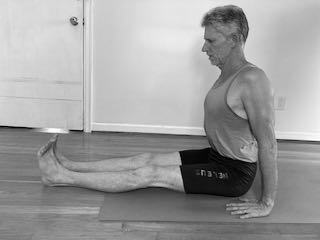
paścimottānāsana A
Pronunciation
English: West Stretching Out Posture
Note: paścima means “western”. Since in Vedic ritual tradition the primary agent of the sacrifice faced East, the “west” refers to the back of a purson. The idea is that in a forward bend the back gets a stretch.
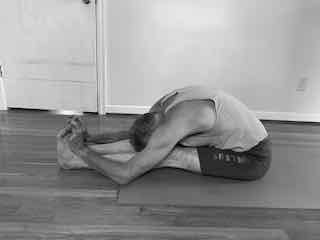
Entering vinyāsa into A (2):
- inhale: take big toes with thumbs and forefingers, lengthen spine, look up
- exhale: fold forward
paścimottānāsana B
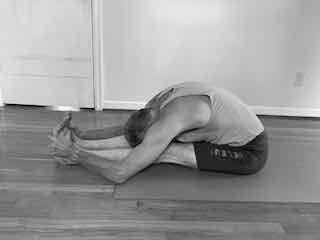
Transition vinyāsa to B (2):
- inhale: straighten the spine and look up, grasping around soles of feet
- exhale: fold forward
paścimottānāsana C
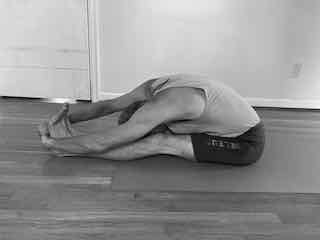
Transition vinyāsa to C (2):
- inhale: straighten the spine and look up, clasping left wrist with right hand beyond feet
- exhale: fold forward
Exiting vinyāsa from C (1):
- inhale: straighten the spine and look up
pūrvottānāsana
Pronunciation
English: East Stretching out Posture
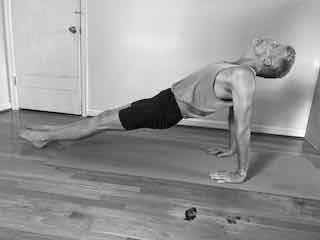
Note: pūrva means “eastern”. Since the Vedic sacrficer faces East, the term also refers to the front of a person. The idea is that one’s front gets a stretch when the body is lifted.
Entering Vinyāsa (3):
- exhale: release hands, place them on the about a foot behind the hips, fingers forward
- inhale: lift the torso, look back
- exhale: hold
Exiting vinyāsa:
- exhale: lower torse back down, sit up to daṇḍāsana
The following sequence of vinyāsas, often referred to as “taking your vinyāsa”, is the standard transition between seated postures:
- inhale: having released the previous posture, lift up
- exhale: jump/step back to caturaṅgadaṇḍāsana
- inhale: to Up Dog
- exhale: to Down Dog
- inhale: jump/step through to sitting
ardhabaddhapadmapaścimottānāsana
Pronunciation
English: Half Bound Lotus West Stretching out Posture
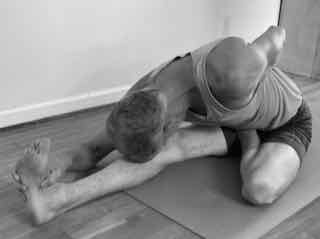
Entering vinyāsa (4):
- inhale: right leg into half-lotus
- exhale: reach right hand around back to bind with right foot
- inhale: take big toe of left foot with free hand, straighten the spine, look up
- exhale: fold forward over the left leg
Exiting vinyāsa (2):
- inhale: lengthen spine, look up
- exhale: release posture
Then:
- take your vinyāsa
- repeat the posture on the other side
- take your vinyāsa
tryaṅgamukhaikapādapaścimottānāsana
Pronunciation
Analysis: tri + aṅga + mukha + eka + pāda + paścima + uttāna + āsana.
English: Three-Limbed Face to One Leg West Stretching out Posture
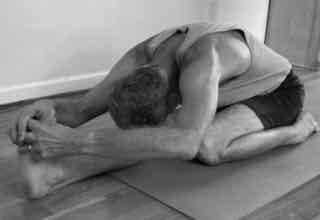
Entering vinyāsa (4):
- inhale: place right foot alongiside right hip, sole up
- exhale: finish the maneuver, or hold
- inhale: lengthen spine, grab around sole of left foot with both hands, look up
- exhale: fold forward over the left leg
Exiting vinyāsa (2):
- inhale: lengthen spine, look up
- exhale: release posture
Then:
- take your vinyāsa
- repeat the posture on the other side
- take your vinyāsa
jānuśīrṣāsana A
Pronunciation
English: Head to Knee Posture
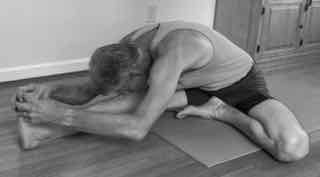
Entering vinyāsa (2):
- inhale: place right foot alongside inner left thigh, heel near groin; grab around sole of left foot with both hands; lengthen spine, look up
- fold forward over the left leg
Exiting vinyāsa (2):
- inhale: lengthen spine, look up
- exhale: release posture
Then:
- take your vinyāsa
- repeat the posture on the other side
- take your vinyāsa
jānuśīrṣāsana B
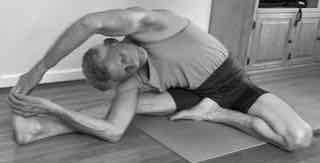
Entering vinyāsa (4):
- inhale: place right foot alongside inner left thigh, heel near groin
- exhale: twist right, placing left hand on floor under right knee, palm down
- inhale: lengthen spine
- exhale: fold and twist down and to the right, over left leg, grabbing left foot with both hands
Exiting vinyāsa (2):
- inhale: lengthen spine, look up
- exhale: release posture
Then:
- take your vinyāsa
- repeat the posture on the other side
- take your vinyāsa
jānuśīrṣāsana C

Entering vinyāsa:
- inhale: lift right leg, grabbing heel and middle of right foot with the hands
- exhale: place ball of right foot on floor against inner left thigh near groin, heel over ball of foot
- inhale: grab around sole of left foot with both hands, lengthen spine, look up
- exhale: fold forward over the left leg
Exiting vinyāsa (2):
- inhale: lengthen spine, look up
- exhale: release posture
Then:
- take your vinyāsa
- repeat the posture on the other side
- take your vinyāsa
marīcyāsana A
Pronunciation
English: Marīci Posture
Note: This posture is dedicated to the sage Marīci.
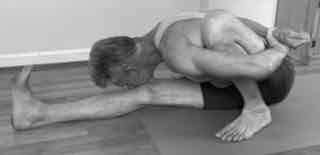
Entering vinyāsa into A (6):
- inhale: bend right knee, planting foot near right hip, lean forward
- exhale: lean forward, right arm reaches forward
- inhale: right arms begins to wrap around
- exhale: left arm reaches around, right hand grabs left hand/wrist
- inhale: lengthen spine, look up
- exhale: fold forward over left leg
Exiting vinyāsa (2):
- inhale: lengthen spine, look up
- exhale: release posture
Then:
- take your vinyāsa
- repeat the posture on the other side
- take your vinyāsa
marīcyāsana B
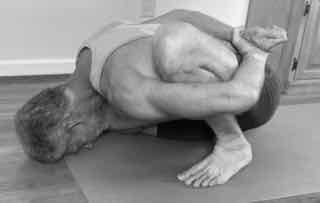
Entering vinyāsa into B (6):
- inhale: right leg into half-lotus
- exhale: bend left knee, planting foot near left hip, lean forward
- inhale: left arm reaches forward and begins to wrap around
- exhale: right arm reaches around, left hand grabs right hand/wrist
- inhale: lengthen spine, look up
- exhale: fold forward, head toward floor
Exiting vinyāsa (2):
- inhale: lengthen spine, look up
- exhale: release posture
Then:
- take your vinyāsa
- repeat the posture on the other side
- take your vinyāsa
marīcyāsana C
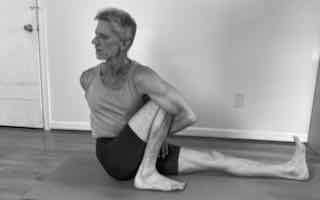
Entering vinyāsa into C (8):
- inhale: bend right knee, planting foot near right hip
- exhale: twist to the right
- inhale: keep twisting until left shoulder is beyond right knee
- exhale: left arm wraps around right shin
- inhlae: right arm begins to reach around
- exhale: left hand grabs right hand/wrist
- inhale: lengthen spine, look up
- exhale: deepen twist into the posture
Exiting vinyāsa (2):
- inhale: lengthen spine, look forward
- exhale: release posture
Then:
- take your vinyāsa
- repeat the posture on the other side
- take your vinyāsa
marīcyāsana D
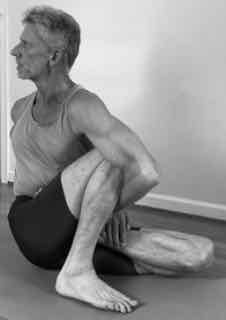
Entering vinyāsa into D (8):
- inhale: right leg into half-lotus
- exhale: bend left knee, planting foot near left hip
- inhale: begin twist to the left
- exhale: keep twisting until right shoulder is beyond left knee
- inhale: left arm begins to wrap around right shin
- exhale: right arm wraps behind back, left hand grabs right hand/wrist
- inhale: lengthen spine, look up
- exhale: deepen twist into the posture
Exiting vinyāsa (2):
- inhale: lengthen spine, look forward
- exhale: release posture
Then:
- take your vinyāsa
- repeat the posture on the other side
- take your vinyāsa
nāvāsana
Pronunciation
English: Boat Posture
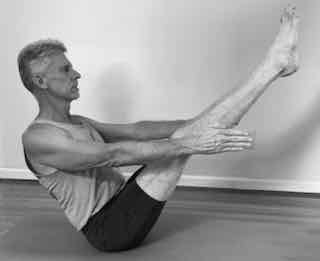
This posture is repeated five times.
Entering vinyāsa (0);
- in the final exhale of “taking your vinyāsa”, you don’t go into seated position; instead you raise the legs and hold out the arms.
Transition vinyāsa between repetitions (2):
- inhale: lift up
- exhale: lower down, raise the legs and hold out the arms
Then take your vinyāsa.
Note: This concludes what is known as “Half-Primary Series.”]
bhujapīḍāsana
Pronunciation
English: Pressure on the Shoulders Posture
Note: pīḍā usually means something like “pain”, or “annoyance”, but here probably substitutes for pīḍana, “pressing”.
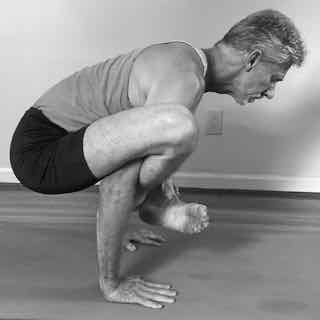
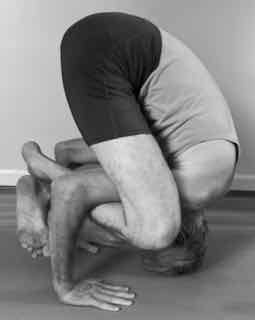
This postures has two phases: A and B.
Entering vinyāsa into A (4):
- inhale: jump/step forward, feet a bit beyond the hands
- exhale: work thighs onto triceps near shoulders
- inhale: using the triceps as a shelf for the body, lift up until feet are off the floor
- exhale: cross the feet, look forward
Transition vinyāsa to B:
- on fifth exhale of A, tuck down into B: bend arms, lower head to floor, crown of head or forehead eventually touching floor
Exiting vinyāsa:
- inhale: lift head back up
- exhale: uncross feet, bend knees fo feet are pointed back, soles up
- inhale: lift body a bit
- exhale: jump back
Continue taking your vinyāsa.
kūrmāsana
Pronunciation
English: Tortoise Posture
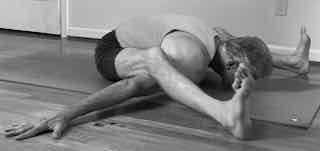
Entering vinyāsa (4+):
- inhale: jump/step forward, feet a bit beyond the hands
- one or more breaths, ending on an exhale: flatten torso towards the floor, with arms out wide under legs, palms down
suptakūrmāsana
Pronunciation
English: Sleeping Tortoise Posture
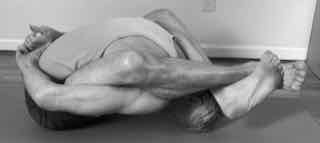
Entering vinyāsa (2+):
- within kūrmāsana, move feet toward each other with the intent to cross the legs at the ankles, behind the head or neck; end on an exhale
Exiting vinyāsa (2):
- inhale: uncross legs
- exhale: sit up
Then take your vinyāsa.
garbhapiṇḍāsana
Pronunciation
English: Embryo in the Womb Posture
Note: garbha is a womb. piṇḍa is a lump or piece of anything, especially a ball of rice, but a classical lexicon also offers the meaning “embryo”.
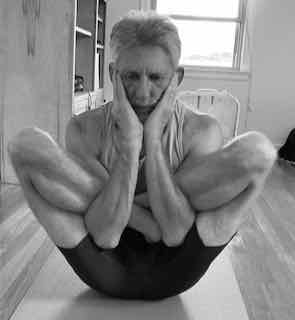
Entering vinyāsa:
- inhale: right leg into half-lotus
- exhale: left leg completes lotus
- inhale/exhale: right arm through gap between thigh and shin
- inhale/exhale: left arm through gap
- inhale: place palms on sides of head
Exhaling roll back, inhaling roll up; repeat 5-9 times.
Note: This is the one of only two postures that are held while moving!]
kukkuṭāsana
Pronunciation
English: Rooster Posture
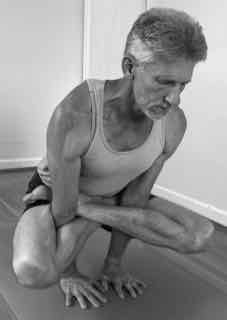
Come up into it on inhale from final roll of garbhapiṇḍāsana.
Posture is held balancing on the hands.
Exiting vinyāsa (3):
- on final exhale, place lower to sit
- inhale: begin to release lotus
- exhale: finish releasing lotus
Take your vinyāsa.
baddhakoṇāsana
Pronunciation
English: Bound Angle Posture
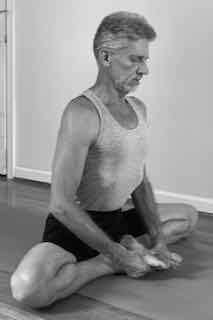
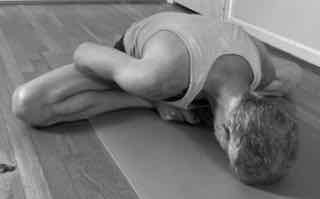
This posture has two phases: A and B.
Entering vinyāsa into A:
- inhale: place soles of feet together near groin
- exhale: open hips to lower knees to floor
Transition vinyāsa to B (2):
- inhale: hold
- exhale: fold forward, head to floor
Exiting vinyāsa (2):
- inhale: rise up
- exhale: release posture
Take your vinyāsa.
upaviṣṭakoṇāsana
Pronunciation
English: “Entered-into” Angle Posture
Note: upaviṣṭa frequently means “seated” but also can mean “entered into” any state or condition. Here it may refer to how one’s forward-folding torso “enters into” the angle formed by one’s legs.]
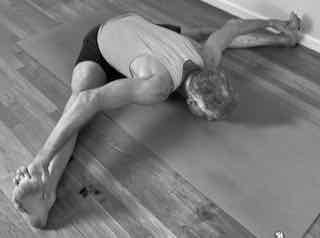
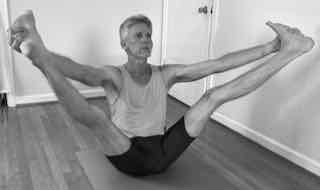
This posture has two phases: A and B.
Entering vinyāsa into A (3):
- last exhale from taking vinyāsa: spread legs out on floor
- inhale: lengthen spine, grab both feet, look up
- exhale: fold forward, torso to floor
Transition vinyāsa to B (2):
- inhale: bring legs up
- exhale: straighten legs, sit back to balance, looking up
suptakoṇāsana
Pronunciation
English: Sleeping Angle Posture
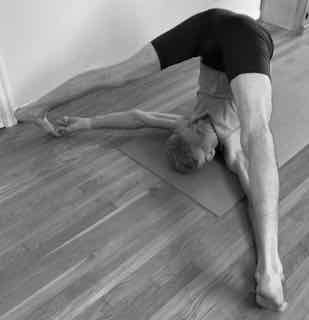

This posture has two phases: A and B.
Entering vinyāsa to A (1):
- last exhale in upaviṣṭakoṇāsana B: roll back onto shoulders, feet to floor; grip has switched to big toes
Transition vinyāsa to B (2):
- inhale: roll up
- exhale: roll down to enter same position as A
Exiting vinyāsa (2):
- inhale: lengthen spine, look up
- exhale: release posture
Take your vinyāsa.
suptapādāṅguṣṭhāsana
Pronunciation
English: Sleeping Thumb-to-Foot Posture

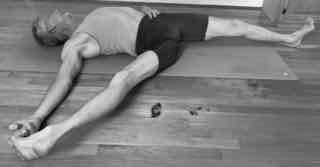
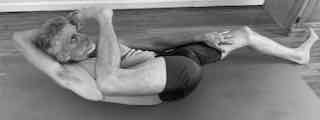

This posture has four phases: A, B, C, D.
Entering vinyāsa into A (3):
- exhale: lie down
- inhale: raise right leg, grasp big toe
- exhale: draw right shoulder back down to floor
Transition vinyāsa to B:
- last exhale of A: lower leg out to right, to the floor
Transition vinyāsa to C (3):
- exhale: bend the right knee a bit and draw the leg in, changing grip on foot
- inhale: draw foot over to right side of the body
- exhale: insert head between right shin and right forearm
Transition vinyāsa to D (2):
- inhale: remove head, place it back to the floor, extend right leg
- exhale: both hands grasp around sole of right foot, drawing the leg toward floor alongside of the head
Exiting vinyāsa (2):
- inhale: hold
- exhale: release foot, lower leg to floor
Repeat the posture on the left side.
Consider taking chakrāsana for the transition to the next posture (or just sit up and take the regular vinyāsana).
ubhayapādāṅguṣṭhāsana
Pronunciation
English: Thumbs to Both Feet Posture
Note: ubhaya = “both”.
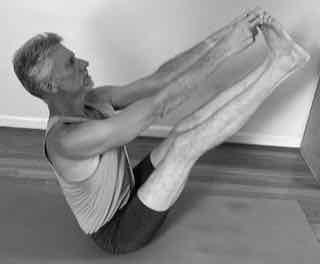

This posture has two phases: A and B.
Entering vinyāsa into A (2):
- inhale: lift both legs, grabbing big toes
- exhale: straighten legs, look up
Transition vinyāsa to B (1):
- final exhale of A: roll back onto shoulders
ūrdhvamukhapaścimottānāsana
Pronunciation
English: Upward Face West Stretching out Posture
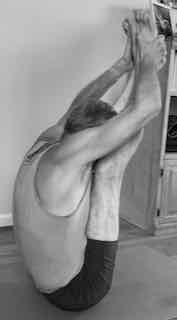
Entering vinyāsa (2):
- inhale: flick shoulders to stimulate the roll up
- exhale: switch grip on feet to around soles, fold toward legs
Exiting vinyāsa (1):
- final exhale of posture: release feet, lower legs
Take your vinyāsa.
setubandhāsana
Pronunciation
English: Bridge-Binding Posture
Note: setu = “bridge”, bandha = “binding”. The compound refers to the forming of a dam or bridge.
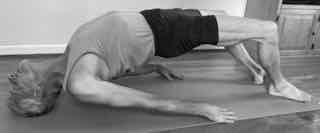
Entering vinyāsa (5):
- exhale: lie back
- inhale: draw feet one third of the way toward the hips
- exhale: place hands under upper thighs
- inhale: arch and place crown of head on floor
- exhale: press up and back, moving hands to floor palms down for support (or in the advanced version, cross your arms over your chest)]
Exiting vinyāsa (1):
- final exhale: lower down, straigthen legs
Consider taking chakrāsana for the transition to the next posture (or just sit up and take the regular vinyāsana).
ūrdhvadhanurāsana
Pronunciation
English: Upward Bow Posture
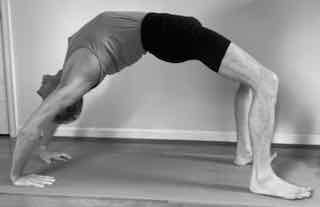
Entering vinyāsa (3):
- exhale: lie back
- inhale: pull feet up
- exhale: set hands
- inhale: press up
Exiting vinyāsa:
- final exhale: come down
Repeat the posture at least three times. Try not to take more than three breaths in between each one.
Afterwards, sit up and do some kind of forward fold.
Take your vinyāsa.
Closing Sequence
Postures in this sequence are held for eight breaths, unless otherwise indicated.
sālambhasarvāṅgāsana
Pronunciation
Analysis: sa + ālambha + sarva + aṅga + āsana
English: Posture where All Limbs are Held Up (AKA Shoulder Stand)
Note: ālambha = “taking, seizing, touching”. The prefix sa carries the meaning “with”, so here sālambha, “with touching” may refer to the way the hands contact the lower back to support the body.
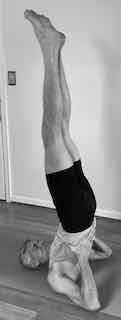
Entering vinyāsa (5):
- exhale: lie down
- inhale: work one should deeply behind back
- exhale: work other shoulder behind back, hands on floor beside hips, palams down
- inhale: roll legs up
- exhale: hands to back, work body more over shoulders
Hold the posture for 10-25 breaths.
hālāsana
Pronunciation
English: Plow Posture
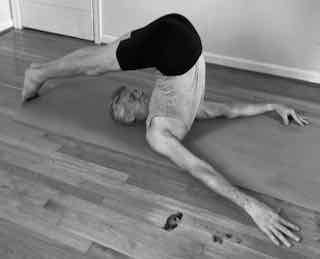
Entering vinyāsa (1):
- final exhale of sālambhasarvāṅgāsana: legs down until toes touch floor behind head, hands to floor, palms down, for support
Note: You may also clasp hands together on the floor.]
karṇapīḍāsana
Pronunciation
English: Pressure on the Ears Posture
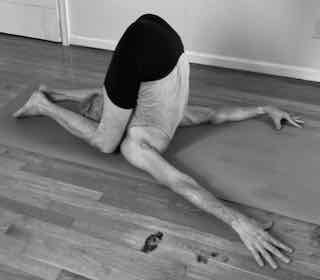
Entering vinyāsa (1):
- final exhale of hālāsana: bend the knees, bringing them near the ears
ūrdhvapadmāsana
Pronunciation
English: Upward Lotus Posture
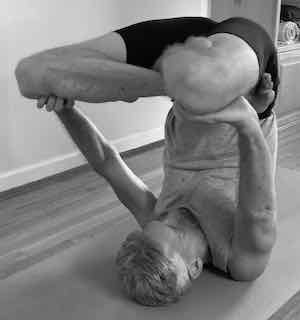
Entering vinyāsa (4):
- inhale: lift legs back to Shoulder Stand, hands return to the back
- exhale/inhale/exhale: place legs in lotus (you may remove hands form back to assist in this), by the end the hands are on the knees with arms straight
piṇḍāsana
Pronunciation
English: Embryo Posture

Entering vinyāsa (1):
- final exhale of ūrdhvapadmāsana: staying in lotus, bring the knees down, clasping hands around to hug around the legs
matsyāsana
Pronunciation
English: Fish Posture
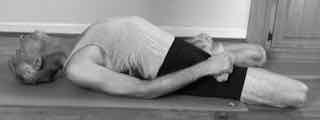
Entering vinyāsa (5):
- final exhale of piṇḍāsana: roll down along spine
- inhale: hands under upper thigns, lift hips slightly, supporting lower bodu on elbows
- exhale/inhale/exhale: arch back, work crown of head to floor, place hands on feet with arms straight
uttānapādāsana
Pronunciation
English: Legs Stretching out Posture
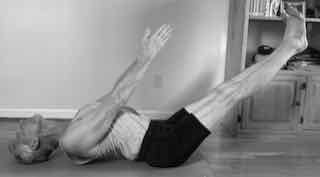
Entering vinyāsa (2):
- inhale: release hands from feet
- exhale: release lotus, extend legs and arms
Consider taking chakrāsana for the transition to the next posture (or just sit up and take the regular vinyāsana), but only halfway (see next posture).
śīrṣāsana
Pronunciation
English: Head[stand] Posture

Entering vinyāsa:
- inhale: from Down Dog, form a triangle with the forearms
- exhale: nestle head between palms, walk feet toward head
- inhale: lift up into posture
Hold for 10-15 breaths.
ūrdhvadaṇḍāsana
Pronunciation
English: Upward Stick Posture
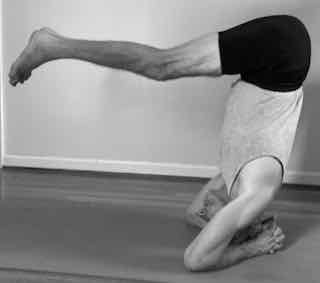

This posture has two phases: A and B.
Entering vinyāsa into A (1):
- final exhale of śīrṣāsana: lower legs halfway down
This posture is held for five breaths.
Transition vinyāsa to B (1):
- inhale: raise legs back up to śīrṣāsana
For B:
- exhale: lower legs until toes nearly touch the floor
- inhale: raise legs back up to śīrṣāsana
Repeat the above motion ten times.
Note: This is the second and last posture that is “held” while moving.
bālāsana
Pronunciation
English: Child Posture
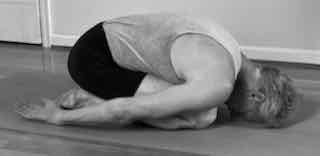
Entering vinyāsa:
- exhale: lower legs until toes touch the floor, bend knees, come down into posture
Hold this posture 4-5 breaths.
baddhapadmāsana
Pronunciation
English: Bound Lotus Posture

Entering vinyāsa: Most people just rise from bālāsana and sit down, then:
- inhale: right leg into half-lotus
- exhale: left leg completes lotus
- inhale: left arms wraps around
- exhale: left hand grabs left foot
- inhale: right arms wraps around
- exhale: right hand grapbs right foot
- inhale: look up
- exhale: fold forward, head to floor
Exiting vinyāsa (1):
- inhale: rise back up, release feet
padmāsana
Pronunciation
English: Lotus Posture
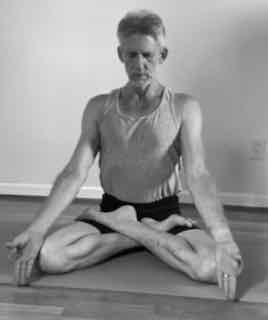
Entering vinyāsa (1):
- exhale: hands to knees, in mudrā
Hold this posture 10-25 breaths.
tolāsana
Pronunciation
English: Tola Posture
Note: Monier-Williams cites tolana as “lifting up” in the Rāmāyana. But tola itself is a classical standard measure, said to be the weight of 100 Gunja seeds. This amounts to only 12 grams more or less, so perhaps the idea was to make a joke for beginning practitioners. When BNS Iyengar started recommending that practitioners perform bhastrika breathing while in this posture, he began to refer to it as utpluthiḥ, “jumping up”.
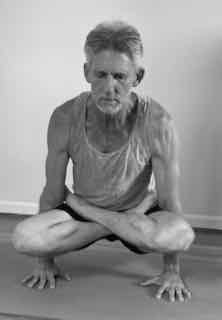
Entering vinyāsa:
- inhale: releasing hands from mudrā, place them on the floor palms beside hips and lift off the floor
Hold this posture at least five breaths. (Some suggest working up to 25 breaths; others suggest that the number of breaths should equal one’s age.)
Exiting vinyāsa (1):
- exhale: lower back down
- inhale/exhale: release lotus, lie down into śāvāsana
śāvāsana
Pronunciation
English: Corpse Posture

-
The term vinyāsa is often used loosely to refer to the sequence of movments that form a transition from one seated posture to the next—liftng up, jumping/stepping back to plank, up-dog, down-down, jump/step through to a sitting position to begin the next posture—but here it is used in its strict sense as one-half of a breath (either the inhale or the exhale) that is to be associated with a particular movement between postures as opposed to breaths taken while in the postures themselves.
Both the loose and strict sense of the term appear to have been introduced in the 20th century, probably by Tirumalai Kṛśṇamācharya, the developer of Aṣṭāṅga Yoga. See this article for more information on the term.] ↩︎